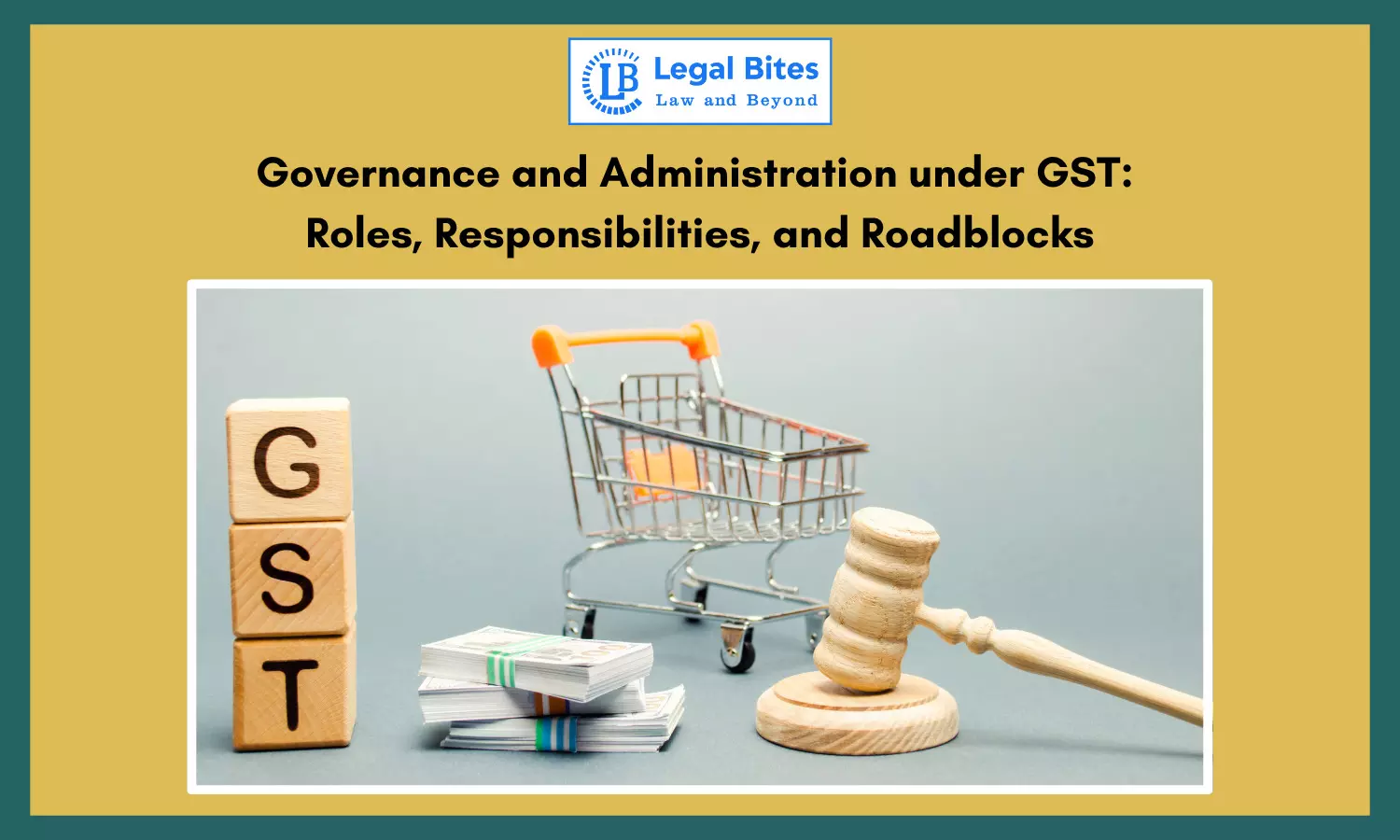Governance and Administration under GST: Roles, Responsibilities, and Roadblocks
GST unifies India’s tax system, removes cascading taxes, boosts ease of business, enhances compliance, and promotes cooperative federalism.

The Goods and Services Tax (GST), implemented in India on July 1, 2017, revolutionised the country's indirect tax system. Replacing a complex web of central and state levies with a unified tax structure, GST aimed to simplify compliance, reduce cascading effects, and ensure a seamless flow of credit. However, the success of this transformative reform hinges significantly on its administration—that is, the structure, roles, responsibilities, and coordination between different authorities...
The Goods and Services Tax (GST), implemented in India on July 1, 2017, revolutionised the country's indirect tax system. Replacing a complex web of central and state levies with a unified tax structure, GST aimed to simplify compliance, reduce cascading effects, and ensure a seamless flow of credit. However, the success of this transformative reform hinges significantly on its administration—that is, the structure, roles, responsibilities, and coordination between different authorities at the Centre and the States.
This article delves into the administrative framework under GST, analyses the division of powers, discusses coordination mechanisms, and addresses challenges in its implementation and enforcement, along with referencing relevant statutory provisions and case law.
Constitutional Basis and Legal Framework
The constitutional foundation of GST lies in the 101st Constitutional Amendment Act, 2016, which introduced Article 246A, granting concurrent taxing powers to both the Centre and States. The Goods and Services Tax Council (GSTC) was established under Article 279A, playing a pivotal role in policymaking.
Key legislative instruments include:
- Central Goods and Services Tax Act, 2017 (CGST Act)
- Integrated Goods and Services Tax Act, 2017 (IGST Act)
- Union Territory Goods and Services Tax Act, 2017 (UTGST Act)
- Respective State GST Acts
These statutes collectively regulate registration, levy, collection, assessment, audit, appeal, and penalties under the GST regime.
Administrative Structure of GST in India
The GST administration in India operates under a dual model—with both the Central Board of Indirect Taxes and Customs (CBIC) and State GST departments administering the tax in parallel.
1. Central GST Administration
The CBIC is entrusted with:
- Collection and administration of CGST and IGST on inter-state supplies and imports
- Issuance of guidance and procedural frameworks (rules, notifications, circulars)
- Developing the back-end IT systems via the Goods and Services Tax Network (GSTN)
- Managing anti-evasion and enforcement activities
2. State GST Administration
State Governments are responsible for:
- Administration and collection of SGST on intra-state supplies
- State-level audits, inspections, and assessments
- Registration and enforcement of tax compliance within their jurisdictions.
The Goods and Services Tax Council (GSTC)
The GST Council is the apex policy-making body governing GST-related decisions. It comprises:
- Union Finance Minister (Chairperson)
- Union Minister of State for Finance/Revenue
- State Finance Ministers (or equivalent)
Key Functions:
- Recommending tax rates, exemptions, and model laws
- Overseeing special provisions for certain states (e.g., Northeast)
- Decision-making on threshold limits and procedural reforms
All decisions require a three-fourth majority, ensuring both Centre and States have proportionate say.
Role of GSTN (Goods and Services Tax Network)
The GSTN is a not-for-profit, non-governmental entity providing the shared IT infrastructure for GST implementation.
Key Features:
- Acts as the interface for taxpayers and tax administrators
- Facilitates e-filing of returns, e-way bills, and refunds
- Supports data analytics, compliance tracking, and inter-agency coordination
GSTN manages the backend systems of 27 states and UTs, while their respective state governments maintain the rest.
Taxpayer Compliance and Administration Mechanisms
1. Registration
Under Section 22 of the CGST Act, registration is mandatory for suppliers whose aggregate turnover in a financial year exceeds the prescribed threshold—₹40 lakhs for suppliers of goods and ₹20 lakhs for suppliers of services, subject to a lower threshold of ₹10 lakhs or ₹20 lakhs in specified special category states.
2. Invoicing and Filing Returns
Proper documentation and timely filing of returns (GSTR-1, GSTR-3B, etc.) form the cornerstone of GST compliance. Return filing helps in:
- Matching Input Tax Credit (ITC)
- Enabling refunds
- Detecting non-compliance
3. Assessment and Audit
GST officers can undertake:
- Self-Assessment under Section 59
- Provisional Assessment under Section 60
- Scrutiny of Returns under Section 61
- Audit by Tax Authorities under Section 65
They can also conduct special audits under Section 66, with prior approval from the Commissioner.
Enforcement and Anti-Evasion Measures
1. Inspections, Search and Seizure
Under Sections 67–72 of the CGST Act, officers can:
- Inspect places of business
- Conduct search and seizure operations
- Detain goods and conveyances in case of irregularities
2. Arrest and Prosecution
In serious cases of tax evasion (e.g., ITC fraud over ₹5 crores), the Act empowers officers to arrest and prosecute offenders.
3. Advance Ruling Mechanism
The Authority for Advance Rulings (AAR) provides binding decisions on classification, taxability, and ITC eligibility to promote certainty and compliance.
Dispute Resolution and Appellate Structure
A multi-tier dispute resolution framework exists:
- Adjudication by the proper officer
- Appeal to Appellate Authority under Section 107
- Appellate Tribunal (National and State Benches)
- High Court and Supreme Court
The proposed GST Appellate Tribunal (GSTAT) aims to streamline dispute resolution. However, its delayed constitution has caused significant pendency.
Case Law
[1] Union of India & Anr. v. M/s Mohit Minerals Pvt. Ltd. (2022)
The Supreme Court held that the recommendations of the GST Council are not binding on the Union or States, affirming the constitutional principle of cooperative federalism under Article 246A and 279A. The Court upheld the validity of GST notifications imposing IGST on ocean freight under CIF (Cost, Insurance, and Freight) contracts, recognising Parliament’s power to tax extra-territorial events with a nexus to India.
However, it struck down the separate levy on ocean freight services as violative of the concept of composite supply under Section 8 of the CGST Act, since the importer already pays IGST on the entire CIF value. Thus, taxing the service component separately resulted in double taxation, contrary to GST’s scheme.
Cooperative Federalism in GST Administration
GST administration exemplifies cooperative federalism, with both Centre and States working in tandem. Major collaborative efforts include:
- Joint audits and investigations
- Unified tax return formats
- Common IT portals and databases
Despite occasional disputes over compensation and rate-setting, the overall structure remains a testament to Centre-State partnership.
Challenges in GST Administration
1. Technical and Infrastructure Issues
Frequent glitches in the GSTN portal, especially during filing deadlines, continue to affect taxpayers and administrators alike.
2. Compliance Burden on Small Taxpayers
Multiple returns, complex classification codes (HSN/SAC), and audit provisions impose a disproportionate burden on small businesses.
3. Dual Control and Overlapping Jurisdictions
Ambiguity in taxpayer jurisdiction between Centre and States sometimes leads to:
- Multiple notices
- Conflicting audits
- Legal uncertainty
4. Evasion and Bogus ITC Claims
Fake invoices, shell companies, and circular trading schemes have become rampant, challenging enforcement capacities.
5. Lack of Timely Dispute Resolution
The absence of a functional GST Appellate Tribunal has created a backlog of unresolved disputes, hampering legal clarity.
Reforms and Recommendations
1. Simplification of Return Filing
The government’s QRMP Scheme and pre-filled returns are steps toward easing compliance. A further reduction in filing frequency can benefit MSMEs.
2. Robust Audit Trails and Data Analytics
Artificial Intelligence and blockchain could be leveraged to trace supply chains, detect fake invoices, and ensure audit readiness.
3. Operationalising the GSTAT
Expediting the constitution of GSTAT is vital for resolving appeals efficiently and reducing litigation costs.
4. Enhancing Inter-Governmental Coordination
Clear protocols and integrated audit plans can reduce duplication and enhance trust among Central and State officers.
5. Capacity Building
Regular training for tax officials, coupled with taxpayer outreach, can improve the quality of administration.
Conclusion
The administration of GST in India is an evolving domain marked by significant achievements and persistent hurdles. While the framework is ambitious in its scale and reach, it demands continuous reform, technological upgradation, and Centre-State coordination to fulfil its promise of a seamless, efficient, and taxpayer-friendly regime. As the GST system matures, adaptive governance and proactive administration will be the keys to its long-term success.
References
[1] The Constitution (One Hundred and First Amendment) Act, 2016
[2] Central Goods and Services Tax Act, 2017
[3] Integrated Goods and Services Tax Act, 2017
[4] Union of India & Anr. v. M/s Mohit Minerals Pvt. Ltd. (Civil Appeal No. 1390 of 2022)

Ajay Kulkarni
Ajay Kulkarni completed his undergraduate studies at the University of Texas and earned his LL.B. from the Faculty of Law, University of Delhi. A qualified Company Secretary (CS), he specializes in Taxation Law with a keen interest in the evolving landscape of Indian and international tax regulations.
